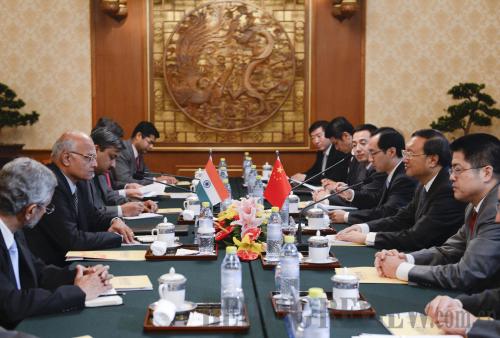|
 |
|
BOUNDARY ISSUES: Chinese State Councilor Yang Jiechi (second right) and Indian National Security Adviser Shiv Shankar Menon (second left) attend the 16th round of China-India special representative meeting on the disputed border region in Beijing on June 29 (XINHUA) |
India's recent announcement to develop unilaterally and independently the disputed China-India border region without loans from the Asian Development Bank once again spurred public concern over the Sino-Indian border disputes following the "tent confrontation" incident between the two armies this April. The region, which China calls Zangnan (South Tibet) and India calls Arunachal Pradesh, is currently under Indian control. It is undeniable that overheated media reports on Sino-Indian border disputes in recent years are partly exploited to attract attention, but it also shows that the border dispute is one of the most sensitive issues in terms of Sino-Indian relations.
Although a final settlement over the border issue cannot be immediately achieved, both sides share a similar willingness to resolve the dispute as their stances gradually converge. The key to resolving the issue completely is to enhance mutual political trust.
Creeping progress
The Sino-Indian border dispute is a complicated historical issue. The two countries have lived in peace with each other in spite of no official boundary in the contested area. However, it is not a coincidence that the border issue became a major barrier impacting bilateral relations over the past six decades.
Historically, the two countries have formed a traditional borderline in the east based on the traditional living habits of the two peoples and the boundary of administrative jurisdiction of each country. For over 2,000 years, the two peoples have respected this fixed borderline and developed a kind of permeable relationship. However, starting with British colonial rule in South Asia, the British Empire sought to expand the borders of its colony of British India to surrounding countries. British colonists also illegally signed a Simla Accord with China's Tibetan local government and set the so-called McMahon Line to define the China-India eastern border. Following independence, India inherited the British colonial legacy and advanced its borderline with China to the McMahon Line in the 1950s. In the meantime, India also put forward its territorial claim in the western part of the China-India border. After the China-India border war in 1962, the two countries formed the current line of control in their respective borders.
The settlement of bilateral border disputes has been always a top priority of bilateral relations. Since the two countries began border talks in 1981, the two sides have successively established vice-ministerial level talks, joint working group talks, China-India border issue diplomats and military experts' panel meetings, special representatives meetings as well as the Working Mechanism for Consultation and Coordination on India-China Border Affairs. These platforms have made gradual progress. In 1993, China and India signed the Maintenance of Peace and Tranquility along the Line of Actual Control in the India-China Border Areas; and later in 1996, the two sides signed the Confidence Building Measures in the Military Field along the Line of Actual Control in the India-China Border Areas. The two pacts allowed both sides to lay a solid foundation for maintaining long-term peace and security in the disputed area.
Special representatives were also appointed with the political mandate to steer negotiations in 2003, discussing the framework on settling the border issue. The first round of the special representative meeting established a three-step development strategy over the border dispute settlement: making the guiding principle, and then setting up a framework agreement to implement the guiding principle and setting the borderline at last. During the fifth round of special representative talks in 2005, the two sides finally reached the Agreement on the Political Parameters and Guiding Principles for the Settlement of the Boundary Question. Though no consensus has been reached over the framework, the objective of the second stage is very obvious for the two sides—that is, setting up the framework as soon as possible.
During Chinese Premier Wen Jiabao's official visit to India in December 2010, the two sides reached consensus and signed an agreement on the Working Mechanism for Consultation and Coordination on India-China Border Affairs. It mainly provides channels for communication and exchange between the two sides and ensures the peace and stability of the disputed area to create good conditions for a final border dispute settlement.
The two sides have formed an overall roadmap for dispute resolution. First, the two countries established the principle of settling the disputes through peaceful means; second, the two reached consensus that they should resolve their differences over the issue in a fair, reasonable and mutually acceptable way; third, they set a three-step strategy with high operability; fourth, they made up the principle of resolving the problem eventually as a package rather than step by step; and last, the two agreed to guarantee peace and stability on the border to create a good atmosphere for the final resolution of the issue.
| 